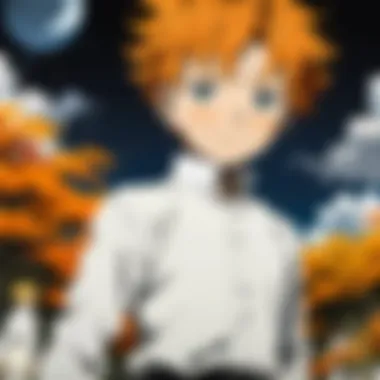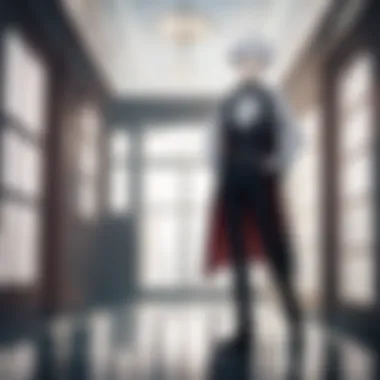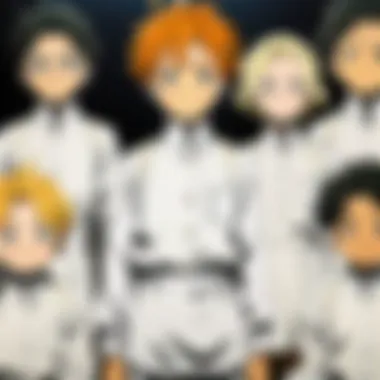An In-Depth Examination of The Promised Neverland Season Two


Intro
The Promised Neverland has captivated audiences with its unique narrative and emotional depth from its inception. As the second season unfolds, the focus shifts from a perilous escape to a more complex exploration of the world beyond the Grace Field House. This transition provides fertile ground for rich character development and keeps viewers engaged with intricate themes that resonate on multiple levels.
Character Analysis
Overview of Character Development
In Season Two, the primary characters, Emma, Ray, and Norman, each navigate their post-escape realities. Emma embodies hope and determination, constantly striving to save not just her friends but all children caught in a dire fate. Ray's character evolves as he grapples with his intelligence and moral dilemmas, showcasing a more vulnerable side that contrasts with his earlier stoicism. Norman’s return introduces new layers to the narrative, as he balances expectations with the reality of the cruel world they inhabit.
"Character development in Season Two reveals the fragility of hope and the burden of choices made in desperation."
These arcs reflect significant growth, as each character confronts their past while forging paths toward a uncertain future. Unlike the first season, where survival was the only focus, the characters' complexities come to light as they address their motivations and fears.
Key Relationships and Dynamics
The triad relationship between Emma, Ray, and Norman remains central throughout the season. Their camaraderie is tested by suspicion and differing ideologies. For instance, Emma’s unwavering belief in saving everyone contrasts sharply with Ray’s pragmatic approach.
- Emma’s idealism often leads her to make decisions that put her at odds with Ray’s more calculated plans.
- Norman’s duality as both a comrade and a figure of sacrifice brings tension, unveiling deeper layers of trust and betrayal.
Additionally, the introduction of new characters challenges existing dynamics. Their interactions highlight the importance of adaptability in relationships. Sympathy and conflict intertwine, leaving viewers to ponder the ethics of survival amidst horror.
Thematic Exploration
Central Themes and Messages
One of the primary themes of Season Two is the notion of choice. The characters are faced with decisions that affect not only their lives but also those of others. This raises questions about the moral implications of their actions within a constrained environment. The theme of hope is also prevalent, often juxtaposed with despair, urging characters to confront their ideals.
Moreover, the narrative also explores the impact of trauma on growth. The experiences that shaped Emma, Ray, and Norman deeply affect how they handle their new realities. Each choice they make is a reflection of their journey, highlighting that growth stems from struggle.
Cultural Context and Influences
The Promised Neverland integrates influences from various cultural narratives surrounding sacrifice, survival, and the essence of humanity. The depiction of children facing adult dilemmas urges viewers to reflect on societal structures and the innocence lost in the fight for existence. It calls into question what it means to protect the vulnerable while also challenging dominant ideologies around strength and agency.
As the evolution of characters continues, it becomes evident that the series is not just a story about escape but about the moral landscapes we navigate when confronted with overwhelming odds. This adds a layer of depth that resonates strongly with contemporary audiences.
Closure
An examination of The Promised Neverland Season Two reveals much about character development and thematic content. It transcends the fate of its characters, reaching into the hearts and minds of viewers. As the series progresses, the ultimate question remains: what does it truly mean to be free?
Overview of The Promised Neverland
In this section, we will explore the fundamental aspects of The Promised Neverland, focusing on its creation and the overarching narrative introduced in the first season. Understanding this foundation is crucial as it sets the stage for the themes and character complexities observed in Season Two.
Initial Concept and Creation


The Promised Neverland originated from a manga written by Kaiu Shirai, with illustrations by Posuka Demizu. The series debuted in 2016 and quickly gained traction for its unique blend of horror, mystery, and psychological thriller elements. The core concept revolves around a group of children living in a seemingly idyllic orphanage, who eventually uncover dark truths about their existence. The initial concept emphasizes themes of innocence contrasted with brutal reality, which resonated well with a broad audience.
The creative team behind the anime adaptation understood the importance of fidelity to the source material while also considering the medium's demands. The production aimed for a visual style that could effectively convey the manga's haunting atmosphere. This attention to detail combined with a thoughtful narrative approach helps establish the emotional and psychological tones necessary for engaging the audience.
A key focus during the adaptation process was to maintain the intricate relationships among characters. Their dynamic interactions would serve as a crucial element in driving the plot forward. This blend of tension, strategy, and emotional depth enhances the viewing experience and builds a strong connection to the audience.
Summary of Season One
The first season of The Promised Neverland consists of 12 episodes released in 2019. It introduces viewers to the lives of Emma, Ray, and Norman, three orphans who discover the horrifying truth of their existence: they are livestock, raised for consumption by demons. This revelation sets off a chain of events filled with suspense and strategic maneuvers.
As the narrative unfolds, the trio devises an escape plan, highlighting their resourcefulness and determination. The season beautifully balances moments of warmth, showcasing the bonds of friendship, with scenes of intense drama and peril, thus keeping viewers on the edge of their seats. The season effectively conveys primal emotions such as fear, hope, and betrayal.
Moreover, the storytelling is enhanced by its pacing and the strategic cliffhangers that propel the viewer's engagement. Each character's motivations are explored comprehensively, functioning to deepen the audience's investment in their fates. The season concludes with a gripping finale that leaves viewers with unresolved questions, setting anticipation for what lies ahead in Season Two.
The Transition to Season Two
The shift from the first season to the second season of The Promised Neverland is pivotal for understanding the evolution of the series. This transition marks not just a continuation of the story but introduces new narrative depths and shifts in tone. With the introduction of new challenges and environments, the dynamics between characters also transform. Exploring this transition allows fans and new viewers alike to grasp the larger themes the series aims to portray.
Shift in Narrative Focus
The narrative in Season Two takes a bold turn, diverging substantially from its predecessor. The initial season is heavily anchored in the theme of escape and survival, primarily centered around the children’s desperate efforts to break free from the orphanage. This urgency motivates the plot and the characters’ actions. However, as Season Two unfolds, the focus shifts towards the broader implications of their choices and the weight of their past.
One notable aspect is how Emma’s motivations deepen. In the first season, her determination is mainly fueled by a will to save her friends. In the second season, she must grapple with the consequences of her actions. Themes of morality and leadership come to the forefront as she faces not just physical battles but ethical dilemmas. The series begins to explore what it means to lead and protect in a world riddled with danger and betrayal.
This change is crucial because it transforms the viewing experience, urging the audience to reflect on the complexities of the characters and their environment. The narrative does not shy away from unfair realities, allowing characters like Emma, Ray, and Norman to evolve under the weight of their choices. Such character development resonates with viewers, making the series more relatable and thought-provoking.
Production Changes
Another significant element in the transition to Season Two is the changes behind the scenes in its production crew. The first season, crafted by CloverWorks, established a unique visual style and an impressive atmospheric tone that captivated audiences. However, the second season saw shifts in direction and writing that affected the adaptation of the source material.
While some fans appreciated these new creative choices, there were mixed reactions regarding pacing and story arcs. Certain plot points from the manga were condensed or altered, leaving fans divided. For instance, the accelerated timeline and condensed character arcs led to a variety of interpretations among audiences, with many noting that some character developments felt rushed.
Despite these controversies, it is essential to view these production changes as part of the creative journey. Different perspectives within the production team can lead to innovative storytelling, even if they diverge from established sources. Understanding these shifts helps in appreciating the challenges in adapting a complex narrative while trying to maintain audience engagement. Therefore, these elements of transition are fundamental to grasping the intricacies of The Promised Neverland's second season.
Character Development in Season Two
Character development is a crucial element in any narrative, and in The Promised Neverland Season Two, it holds significant importance. This season takes various established characters and further deepens their roles, motivations, and relationships. The growth of characters like Emma and Ray provides the foundation for the thematic exploration of the series. By closely analyzing their journeys, the audience can gain insights into how personal growth affects decisions in dire circumstances.
Additionally, character development enriches the plot, making it more engaging and relatable. In a story centered around survival, understanding each character's evolution encourages viewers to reflect on their values, fears, and hopes. Ultimately, the character arcs in Season Two allow for a more profound engagement with the series' implications and its commentary on human nature.
Emma’s Evolution
Emma’s development is central to the narrative arc of Season Two. At the start of the season, she confronts the reality of life outside the orphanage. This reality forces her to reassess her ideals of family, hope, and freedom. Emma transforms from a naive dreamer into a determined leader who must navigate complex moral dilemmas.
She juggles her compassion for others against the harsh truths of their world. Her growth reflects the series' overarching themes of sacrifice and the burden of leadership. Emma's choices become pivotal in shaping the future of her friends and the remaining children. As she evolves, viewers witness a struggle that feels both deeply personal and universally relevant.


Ray’s Arc
Ray's character arc in Season Two unveils layers of complexity that contribute to the story's depth. Unlike Emma, who embodies hope, Ray represents pragmatism. His decisions often stem from a desire to strategize and safeguard their group. Throughout the season, Ray grapples with his past and initial loyalties, leading to substantial personal conflict.
This struggle highlights the themes of betrayal and trust. Ray’s actions challenge the notion of whether the ends justify the means. His evolution from a reserved and somber child into someone who takes bold actions reflects his internal conflict between self-interest and friendship. This duality adds a rich texture to the storyline, engaging viewers who resonate with his plight.
Other Significant Characters
Apart from Emma and Ray, Season Two explores the development of other significant characters. Characters such as Norman and the new additions to the cast play vital roles in shaping the main storyline.
- Norman's Return: His reappearance introduces various emotional dynamics, especially with Emma and Ray. This dynamic adds intensity to their relationships, forcing each character to confront past traumas and future uncertainties.
- New Characters: The introduction of new figures like the Lambda children enriches the world-building and adds perspectives on the overarching threats they face. These new characters bring fresh opportunities for growth and conflict, further pushing the main cast to evolve in response to their presence.
The character development throughout the season plays a pivotal role in the narrative. It enhances understanding of the series' delicate themes and reinforces the stakes associated with personal choices. As a narrative device, it allows the audience to engage with the material on a more profound level, thus making The Promised Neverland Season Two a noteworthy installment in the franchise.
Thematic Exploration
The thematic exploration in this analysis of The Promised Neverland Season Two is essential for understanding the intricacies of the narrative and the characters. Themes such as survival, sacrifice, trust, betrayal, hope, and despair are interwoven in the series. By examining these themes, the audience gains insight into the moral dilemmas faced by the characters. Each theme not only reflects the struggles of the characters but also resonates with the viewer's experiences, making the story more impactful.
Survival and Sacrifice
In Season Two, survival becomes a central motif driving the characters' actions. The harsh realities they face force them to make tough decisions that often involve personal sacrifice. Emma, for instance, embodies this conflict. Her desire to save her friends clashes with the need to secure her own safety. This duality raises questions about the lengths one will go to protect loved ones, even at a personal cost.
Additionally, sacrifice takes various forms in the series. Some characters choose to risk their lives for the sake of others. In contrast, others are willing to betray allies to secure their own survival. Such choices highlight the precarious balance between self-preservation and altruism in dire situations. Understanding these sacrifices enhances appreciation for the emotional depth of the series.
Trust and Betrayal
Trust plays a pivotal role in shaping the relationships between characters. As the story unfolds, the fragility of trust is tested relentlessly. Season Two emphasizes the idea that trust is both a strength and a vulnerability. Characters who foster strong bonds are forced to confront instances of betrayal, which can lead to devastating consequences.
For example, when characters reveal hidden agendas, the fallout is palpable. The reactions of those betrayed lead to shifts in alliances and create tension throughout the season. This exploration of trust and betrayal adds layers of complexity to the narrative and amplifies the stakes for the characters involved.
Hope and Despair
Hope and despair serve as counterpoints throughout Season Two. The relentless struggle against overwhelming odds can lead characters to moments of despair. Yet, the series also offers glimmers of hope that keep characters, and the audience, engaged.
Emma's unwavering determination to find a way out showcases the theme of hope. Her belief in a better future encourages those around her, even when situations seem dire. On the flip side, despair often contrasts this hope, reminding viewers of the harsh realities in the world of The Promised Neverland. This duality not only heightens emotional engagement but also reflects the complex nature of human experience in the face of adversity.
"The themes within the series challenge viewers to confront their own understanding of sacrifice, trust, and hope."
By delving into these themes, one gains a full understanding of what makes Season Two compelling. Each thematic element contributes to the greater narrative, offering perspectives that resonate well beyond the screen.
Comparative Analysis with the Manga
The exploration of the comparative analysis with the manga is crucial in understanding the adaptation process of The Promised Neverland. By focusing on how the anime interprets source material, we can discern the direct impact on narrative pacing, character development, and thematic depth. This comparison allows audiences to appreciate both mediums in their own right, recognizing the creative choices made during adaptation.
Key Differences


Several notable differences exist between The Promised Neverland manga and its second season in anime.
- Pacing Issues: The anime often sacrifices pacing for dramatic effect. Key plot points are sometimes rushed, leading to a less detailed exploration.
- Character Focus: Certain characters receive diminished backstories in the anime. For instance, side characters like Gilda and Don are not as fleshed out, which can affect emotional investment.
- Omissions: Some scenes from the manga are absent in the anime. Critical moments that showcase the complexity of the plot may be omitted, altering viewer perceptions.
These differences highlight the inherent challenges of adaptation, where the essence of the original work may become diluted due to time constraints and targeted narrative direction.
Adaptation Choices
Adaptation choices reflect the creative decisions that significantly shape the viewing experience of the anime.
- Visual Storytelling: The anime employs different visual techniques that may enhance some scenes while losing others' subtlety.
- Narrative Streamlining: Elements of the story are often simplified to maintain audience engagement. This decision may improve the flow for viewers but could reduce depth.
- Character Representation: Changes to character arcs are evident. While some characters gain additional dimensions, others might appear two-dimensional to fit the new narrative structure.
"Adaptation is an art form that balances faithfulness and creative liberty."
Audience Reception
The reception of Season Two of The Promised Neverland plays a crucial role in understanding its overall impact and legacy within the anime community. It reveals how interpretations can vary among critics and fans. This section provides insight into the specific elements that shaped views on the season, discussing both critical reviews and fan reactions in detail.
Critical Reviews
Critical reviews of The Promised Neverland Season Two have revealed a spectrum of opinions. Reviewers pointed out several key aspects of the season. On one hand, some critics praised the animation quality and voice acting, noting how these elements enriched the viewing experience. The shift in direction and pacing, however, received a mixed response. Critics argued that the transition from the source material introduced pacing issues that diminished the tension and intricacy of the plot.
Most reviews highlighted the attempt to condense complex story arcs. This approach may have lost subtleties present in the manga. Critics from various outlets, including Anime News Network and IGN, emphasized the changes in character development, particularly how some supporting characters were not as fleshed out.
One notable point of discussion was the handling of thematic depth. Some believed that significant themes like despair and hope were overshadowed by action-driven sequences. This could explain why several critics felt disappointed compared to the high expectations set by Season One. In summation, critical reviews of Season Two exposed concerns about narrative coherence. While some found merit in the artistic choices, many felt aspects of the original story were compromised to fit a shorter format.
Fan Reactions
Fan reactions to Season Two of The Promised Neverland were diverse and passionate. The division between fans who supported the adaptation and those who were dissatisfied is noteworthy. Many fans expressed their appreciation for the darker and more intense direction of the season. They accepted deviations from the source material as necessary for a new interpretation.
However, a significant contingent of the fanbase criticized the adaptation for its pacing issues and character treatment. On forums such as Reddit, lively discussions revealed frustrations regarding the development arcs of favorite characters. Some felt that the rapid storytelling left little room for emotional connection, particularly with Emma and Ray.
Additionally, social media platforms and fan communities were active in sharing their views. The disparity in reception highlighted the challenges inherent in adapting serialized narratives. Fans of the manga often cited specific moments they felt should have been included, further exacerbating the divide.
"Fans bring unique perspectives and emotional connections that validate the importance of narrative fidelity in adaptations."
Culmination
The conclusion of any analysis is vital, as it encapsulates the primary arguments and sheds light on the overall significance of the topic discussed. In this article, the examination of The Promised Neverland Season Two is no exception. This section draws together the key insights regarding character development, thematic elements, and audience reception. The conclusions we reach here not only reflect on the individual components of the season, but also provide a broader context for understanding its impact within the anime community.
The importance of this part of the article lies in the synthesis of information. By bringing together various threads of analysis, readers gain a comprehensive perspective on how Season Two evolves from its predecessor. It allows for a clear understanding of the series' trajectory and its implications for both new and returning viewers. Furthermore, the examination of critical reviews alongside fan reactions highlights the diverse opinions surrounding the adaptation. It serves not only to inform but also to provoke thought on the future direction of the story.
Final Thoughts on the Series
While Season One of The Promised Neverland established a gripping narrative and rich characters, Season Two shifts the focus in essential ways. It continues to challenge the protagonists while asserting larger themes about humanity, survival, and the cost of freedom. Emma, Ray, and their companions evolve significantly, showcasing resilience against overwhelming odds. The series succeeds in expanding the scope of its storytelling while maintaining tension and suspense. Ultimately, the series stands as a testament to complex storytelling in anime, capturing the nuances of human emotion amid dire circumstances.
Future Expectations
As the narrative progresses, there are many questions about what lies ahead for The Promised Neverland. Fans are eager to see how the remaining arcs will unfold, especially considering the deviations from the source material. The potential for character development remains high as they face new challenges. Future seasons may explore deeper philosophical questions prompted by the series' themes. There is an expectation for a return to the core elements that made the first season compelling, such as strategic thinking and the ethical dilemmas faced by characters.
In essence, as we look forward to more content from The Promised Neverland, anticipation is mixed with skepticism. It will be intriguing to see whether the adaptation can successfully navigate the intricate storylines ahead and satisfy the loyal fan base.













